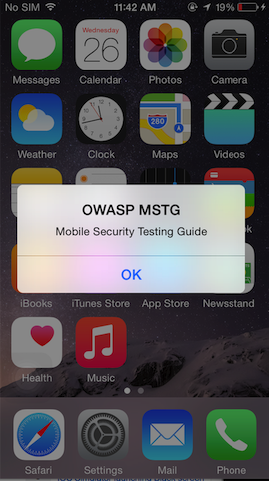MASTG-TOOL-0046: Cycript
Deprecated Tool
This tool is deprecated and should not be used anymore.
Reason: Cycript is no longer actively maintained and fails on modern iOS versions. It last saw meaningful updates between 2009 and 2013. Key components like cynject broke on iOS 12 around 2019 due to changes in Cydia Substrate and have not been fixed. Frida offers broader compatibility, active support, and more powerful dynamic instrumentation capabilities.
Use instead:
Cycript is a scripting language developed by Jay Freeman (aka Saurik). It injects a JavaScriptCore virtual machine into a running process. Using the Cycript interactive console, users can manipulate the process with a hybrid Objective-C++ and JavaScript syntax. Accessing and instantiating Objective-C classes inside a running process is supported. Cycript can be injected into a running process, similar to a debugger, using Cydia Substrate, which is the standard framework for developing Cydia runtime patches known as Cydia Substrate Extensions on iOS. It includes Cynject, a tool that provides code injection support for Cycript.
In order to install Cycript, first download, unpack, and install the SDK.
#on iphone
$ wget https://cydia.saurik.com/api/latest/3 -O cycript.zip && unzip cycript.zip
$ sudo cp -a Cycript.lib/*.dylib /usr/lib
$ sudo cp -a Cycript.lib/cycript-apl /usr/bin/cycript
To spawn the interactive Cycript shell, run "./cycript" or "cycript" if Cycript is on your path.
$ cycript
cy#
To inject into a running process, we first need to find the process ID (PID). Run the application and make sure the app is in the foreground. Running cycript -p <PID> injects Cycript into the process. To illustrate, we will inject into SpringBoard (which is always running).
$ ps -ef | grep SpringBoard
501 78 1 0 0:00.00 ?? 0:10.57 /System/Library/CoreServices/SpringBoard.app/SpringBoard
$ ./cycript -p 78
cy#
One of the first things you can try out is to get the application instance (UIApplication), you can use Objective-C syntax:
cy# [UIApplication sharedApplication]
cy# var a = [UIApplication sharedApplication]
Use that variable now to get the application's delegate class:
cy# a.delegate
Let's try to trigger an alert message on SpringBoard with Cycript.
cy# alertView = [[UIAlertView alloc] initWithTitle:@"OWASP MASTG" message:@"Mobile Application Security Testing Guide" delegate:nil cancelButtonitle:@"OK" otherButtonTitles:nil]
#"<UIAlertView: 0x1645c550; frame = (0 0; 0 0); layer = <CALayer: 0x164df160>>"
cy# [alertView show]
cy# [alertView release]

Find the app's document directory with Cycript:
cy# [[NSFileManager defaultManager] URLsForDirectory:NSDocumentDirectory inDomains:NSUserDomainMask][0]
#"file:///var/mobile/Containers/Data/Application/A8AE15EE-DC8B-4F1C-91A5-1FED35212DF/Documents/"
The command [[UIApp keyWindow] recursiveDescription].toString() returns the view hierarchy of keyWindow. The description of every subview and sub-subview of keyWindow is shown. The indentation space reflects the relationships between views. For example, UILabel, UITextField, and UIButton are subviews of UIView.
cy# [[UIApp keyWindow] recursiveDescription].toString()
`<UIWindow: 0x16e82190; frame = (0 0; 320 568); gestureRecognizers = <NSArray: 0x16e80ac0>; layer = <UIWindowLayer: 0x16e63ce0>>
| <UIView: 0x16e935f0; frame = (0 0; 320 568); autoresize = W+H; layer = <CALayer: 0x16e93680>>
| | <UILabel: 0x16e8f840; frame = (0 40; 82 20.5); text = 'i am groot!'; hidden = YES; opaque = NO; autoresize = RM+BM; userInteractionEnabled = NO; layer = <_UILabelLayer: 0x16e8f920>>
| | <UILabel: 0x16e8e030; frame = (0 110.5; 320 20.5); text = 'A Secret Is Found In The ...'; opaque = NO; autoresize = RM+BM; userInteractionEnabled = NO; layer = <_UILabelLayer: 0x16e8e290>>
| | <UITextField: 0x16e8fbd0; frame = (8 141; 304 30); text = ''; clipsToBounds = YES; opaque = NO; autoresize = RM+BM; gestureRecognizers = <NSArray: 0x16e94550>; layer = <CALayer: 0x16e8fea0>>
| | | <_UITextFieldRoundedRectBackgroundViewNeue: 0x16e92770; frame = (0 0; 304 30); opaque = NO; autoresize = W+H; userInteractionEnabled = NO; layer = <CALayer: 0x16e92990>>
| | <UIButton: 0x16d901e0; frame = (8 191; 304 30); opaque = NO; autoresize = RM+BM; layer = <CALayer: 0x16d90490>>
| | | <UIButtonLabel: 0x16e72b70; frame = (133 6; 38 18); text = 'Verify'; opaque = NO; userInteractionEnabled = NO; layer = <_UILabelLayer: 0x16e974b0>>
| | <_UILayoutGuide: 0x16d92a00; frame = (0 0; 0 20); hidden = YES; layer = <CALayer: 0x16e936b0>>
| | <_UILayoutGuide: 0x16d92c10; frame = (0 568; 0 0); hidden = YES; layer = <CALayer: 0x16d92cb0>>`
You can also use Cycript's built-in functions such as choose which searches the heap for instances of the given Objective-C class:
cy# choose(SBIconModel)
[#"<SBIconModel: 0x1590c8430>"]
Learn more in the Cycript Manual.